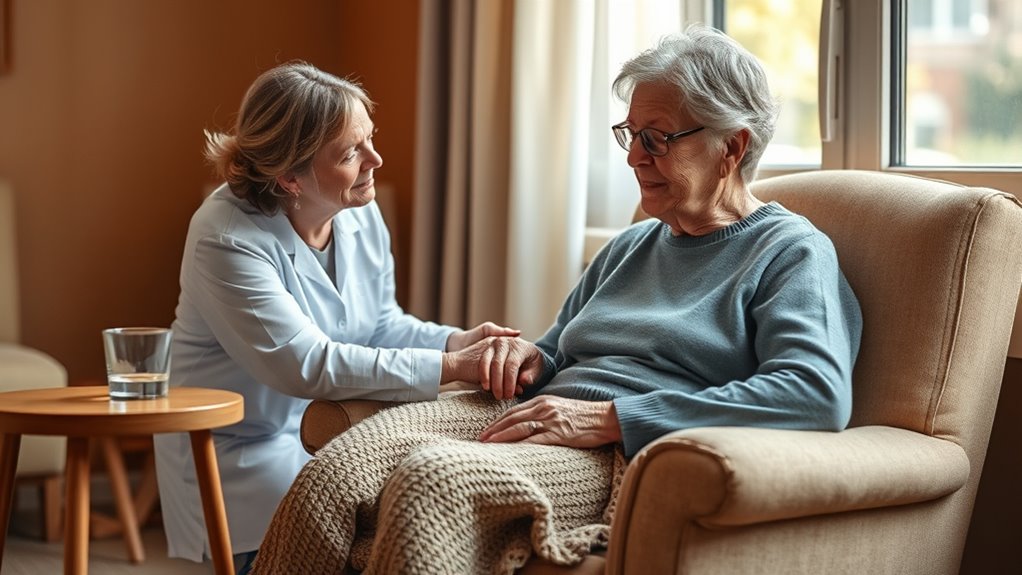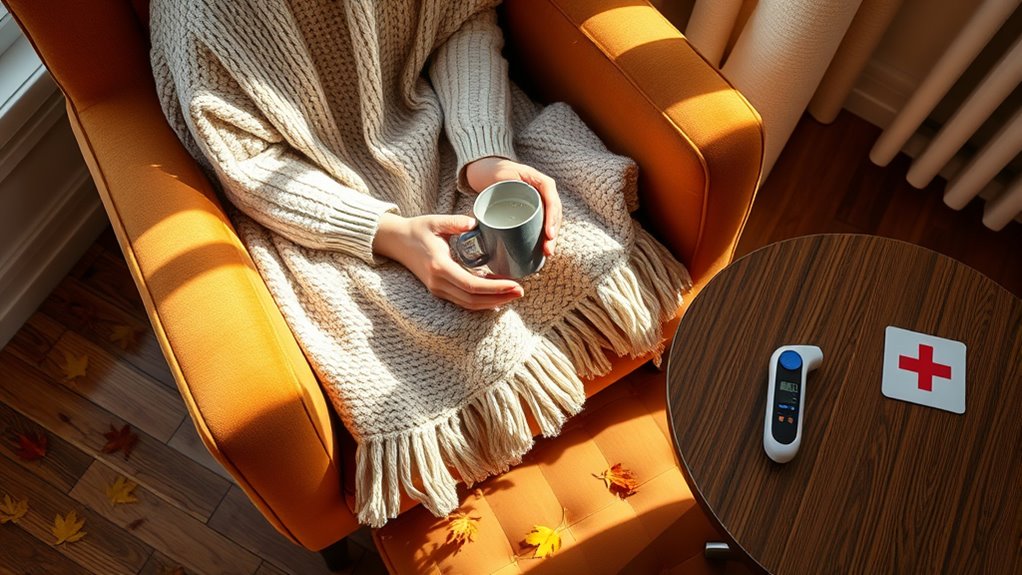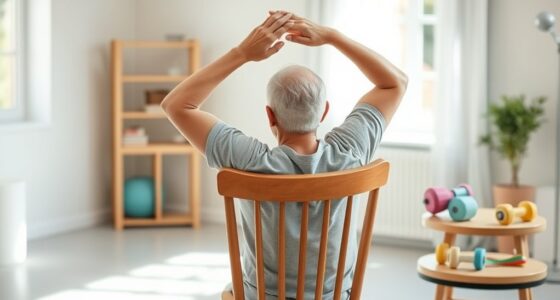After a fall, first assess yourself for injuries and seek medical help if you experience pain, dizziness, or suspect an injury. Rest and avoid putting weight on affected limbs until cleared by a healthcare professional. Check your surroundings for hazards that might have caused the fall and make necessary adjustments to prevent another incident. Focusing on these immediate actions can promote recovery and safety—continue to explore ways to stay secure and healthy after a fall.
Key Takeaways
- Assess yourself for pain or injuries and seek medical help if needed.
- Rest and avoid putting weight on injured limbs until cleared by a healthcare professional.
- Evaluate your surroundings for hazards that may have caused the fall and make safety improvements.
- Perform balance exercises and strengthen muscles to regain stability and prevent future falls.
- Clear clutter, install safety features, and ensure proper lighting to create a safer home environment.

Have you ever experienced a fall that left you shaken or injured? It’s a terrifying experience, and even if you feel okay afterward, it’s important to take immediate steps to guarantee your safety and prevent future incidents. One of the first things you should consider is how to improve your balance. Engaging in simple balance exercises can make a significant difference. These exercises, such as standing on one foot or walking heel-to-toe along a straight line, help strengthen the muscles that keep you steady. Incorporating balance exercises into your routine not only boosts your stability but also builds confidence, decreasing the likelihood of falls in the future. But improving your physical strength isn’t enough if your environment isn’t safe. Home safety measures are just as essential. Clear clutter from walkways, secure loose rugs, and install grab bars in the bathroom. Good lighting throughout your home reduces the chances of tripping over unseen objects. Simple modifications like non-slip mats in the shower and stair railings can provide extra support where it’s needed most. After a fall, it’s imperative to evaluate your surroundings and make necessary adjustments to minimize hazards. If you’re unsure about your home safety, consider getting a professional assessment or asking a trusted family member for help. Remember, fall recovery isn’t just about treating injuries—it’s about creating a safer environment for yourself moving forward. If you experience pain or suspect an injury, seek medical attention promptly. Even minor falls can sometimes lead to underlying issues that require professional care. Rest and avoid putting weight on injured limbs until a healthcare provider advises you otherwise. Once you’re cleared, gradually reintroduce activities that promote strength and stability. Rehabilitation exercises, including balance training, can help you regain confidence and prevent future falls. It’s also wise to discuss your fall with your healthcare provider, especially if you’ve fallen more than once. They can identify underlying health issues such as vision problems, medication side effects, or balance disorders that contribute to your risk. Additionally, understanding the importance of fall prevention can empower you to take proactive steps. Remember, fall recovery is an ongoing process. Consistently practicing balance exercises and maintaining a safe home environment form the foundation of fall prevention. Stay vigilant about your surroundings and keep up with regular health checkups. These proactive steps will help you regain your independence and reduce the fear of falling again. Ultimately, taking control of your safety through practical measures and staying active ensures you can enjoy your daily life with confidence and peace of mind.
Frequently Asked Questions
How Can I Prevent Falls in the First Place?
To prevent falls, focus on home safety by removing tripping hazards like loose rugs and clutter. Make sure your walkways are well-lit and install grab bars in key areas like bathrooms. Choose supportive, non-slip footwear to improve stability. Regularly exercise to strengthen your muscles and improve balance. Staying alert and cautious can also help you avoid falls, keeping you safer in everyday activities.
What Signs Indicate a Serious Injury After a Fall?
If you notice signs of head trauma like confusion, dizziness, or persistent headache, seek medical help immediately. Watch for fracture symptoms such as severe pain, swelling, or deformity around the injured area, along with bleeding or bruising. If you can’t move a limb or experience loss of consciousness, act fast and get professional care. These signs could indicate serious injury and require urgent attention.
When Should I Seek Medical Attention Immediately?
Think of your body as a delicate clock—if any gears stop moving, you need urgent attention. You should seek medical care immediately if you notice emergency symptoms like severe pain, bleeding, difficulty breathing, dizziness, or loss of consciousness. Don’t wait; these signs are signals that your body needs immediate care to prevent further damage. Trust your instincts and get help right away to protect your health and well-being.
Are There Exercises to Improve Balance and Prevent Future Falls?
Yes, you can improve your balance and prevent future falls by doing regular balance exercises like heel-to-toe walks and standing on one leg. Incorporate strength training to boost muscle support, focusing on legs, hips, and core. Consistency is key—practice these exercises several times a week. Over time, you’ll notice better stability, confidence, and reduced fall risk, helping you stay safer and more independent.
How Can Caregivers Assist Someone After a Fall?
Think of yourself as a lighthouse guiding a stranded ship to safety. You can assist someone after a fall by performing a fall assessment to identify injuries and ensuring they’re comfortable. Offer emotional support, reassuring them with calm words. Stay with them, monitor their condition, and encourage medical help if needed. Your steady presence helps rebuild their confidence, just like a lighthouse restores hope for a safe voyage ahead.
Conclusion
Remember, quick action after a fall can prevent serious injuries and even save lives. Did you know that about 20-30% of people who experience a fall suffer from significant injuries, and many could be avoided with prompt care? Stay alert, assess your condition carefully, and don’t hesitate to seek medical help if needed. Taking these steps not only helps in recovery but also reduces the risk of future falls, keeping you safer and healthier.








